
(a) Adaptations of the air ways (trachea and bronchi)
- The walls of the trachea and bronchi are lined by rings of cartilage; which prevent them from collapsing and keep them open for air passage;
- The inner passage of air ways is lined with mucous membrane; which contain ciliated cells; whose movements to and from the pharynx cause a sweeping action that collects mucus containing dust towards the pharynx hence preventing their entry into the air ways;
- The mucous membrane contains mucus secreting cells; which produce mucus that trap dust and pathogenic particles which would find their ways into the air ways;
- The mucous membrane has a rich supply of blood; which helps to keep the incoming air warm and moist for easy diffusion into the lungs;
- The epiglottis and other structures on top of the trachea prevent food, drinks and other soil particles from gong into the trachea during swallowing;
Adaptations of the lungs
- It has numerous alveoli; that provide a large surface area for efficient gaseous exchange;
- Epithelial lining between alveoli wall and the blood capillaries is thin; to provide a shorter diffusion distance for easy gaseous exchange;
- The lung is spongy and has numerous air sacs; that accommodate large volume of gases (oxygen);
- It is highly supplied with blood capillaries that transports oxygen and carbon (IV) oxide to and from the body tissues respectfully;
- Its epithelial lining is covered by a thin layer of moisture; to dissolve oxygen for easy diffusion into the blood stream;
- The lung is connected to tree – like system of tubes (the trachea, bronchi and bronchioles); that supply oxygen and removes carbon (IV) oxide from the lung;
The whole lung is covered with the pleural membrane which is gas-tight thus changes in pressure within the lungs can occur without external interference.
marto answered the question on October 4, 2019 at 10:59
-
The diagram below represents a section of the human respiratory system.
(Solved)
The diagram below represents a section of the human respiratory system.
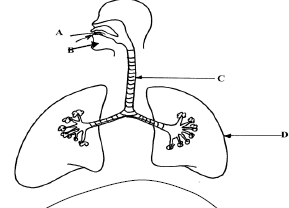
(a) One can inhale through path A, or B. Giving reasons, state the more appropriate path.
(b) How is the part labbelled C adapted for its function?
(c) Explain the effect of regular tobacco smoking to the functioning on the organ labelled D
Date posted:
October 4, 2019
.
Answers (1)
-
Briefly describe how stomata opens.
(Solved)
Briefly describe how stomata opens.
Date posted:
October 4, 2019
.
Answers (1)
-
An athlete training to take part in an international competition moved to a high attitude area where he was to train for twelve days before...
(Solved)
An athlete training to take part in an international competition moved to a high attitude area where he was to train for twelve days before the competition. He took his pulses per minute daily and tabulated them as shown below:-
a) Other than pulse rate, name one other process which was affected by change of altitude
b) Account for the change in pulse rate from:-
i) Day 1 to day 7
ii) Day 8 to day 12
c) Explain the advantage this athlete has over the one who trains in a lower altitude area
d) The equation below represents a reaction which takes place during rapid muscular movements in humans.

i) State two effects of this reaction to an individual
ii) How is lactic acid finally eliminated from the muscle tissues of the human after the muscle
Date posted:
October 4, 2019
.
Answers (1)
-
The diagram below represents an organ from a bony fish. Study the diagram and answer the questions that follow:
(Solved)
The diagram below represents an organ from a bony fish. Study the diagram and answer the questions that follow:
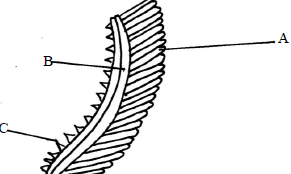
(a) State the functions of each of the following named parts on the diagram.
(b) How is the structure labeled C adapted to its function?
Date posted:
October 4, 2019
.
Answers (1)
-
The set up below represents an experiment to investigate the process of photosynthesis.
The set up placed in sunlight for six hours.
(Solved)
The set up below represents an experiment to investigate the process of photosynthesis.
The set up placed in sunlight for six hours.
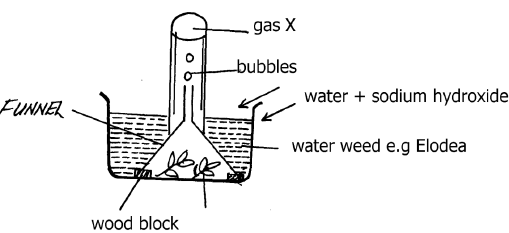
(a) Why was sodium hydrogen carbonate added to water in this experiment?
(b) Explain why the number of bubbles reduced by evening
(c) Explain why the water was used in this experiment
Date posted:
October 4, 2019
.
Answers (1)
-
Why should respiratory surfaces be:
(i) Moist
ii) Thin
(Solved)
Why should respiratory surfaces be:
(i) Moist
(ii) Thin
Date posted:
October 4, 2019
.
Answers (1)
-
Describe the path taken by oxygen gas from atmosphere to the tissues of an insect.
(Solved)
Describe the path taken by oxygen gas from atmosphere to the tissues of an insect.
Date posted:
October 4, 2019
.
Answers (1)
-
a)State two ways in which the surface area of the fish filaments is increased for efficient gaseous exchange.
b)What is the importance of counter flow system...
(Solved)
a)State two ways in which the surface area of the fish filaments is increased for efficient gaseous exchange.
b)What is the importance of counter flow system in the filaments of a fish.
Date posted:
October 4, 2019
.
Answers (1)
-
State two ways in which bodies of people living in high altitude areas respond to low oxygen concentration
(Solved)
State two ways in which bodies of people living in high altitude areas respond to low oxygen concentration
Date posted:
October 4, 2019
.
Answers (1)
-
Describe the changes that occur to the rib cage and the diaphragm during inspiration.
(Solved)
Describe the changes that occur to the rib cage and the diaphragm during inspiration.
Date posted:
October 4, 2019
.
Answers (1)
-
Identify the surfaces of gaseous exchange in the following:-
(i) Paramecium;
(ii) Roots;
(iii) Frog;
(Solved)
Identify the surfaces of gaseous exchange in the following:-
(i) Paramecium;
(ii) Roots;
(iii) Frog;
Date posted:
October 4, 2019
.
Answers (1)
-
Calculate the RQ of the food substance shown by the equation below.
(Solved)
Calculate the RQ of the food substance shown by the equation below.

ii)Name the food substance being oxidized in (i) above.
iii)What is Respiration Quotient (RQ)?
Date posted:
October 4, 2019
.
Answers (1)
-
State two causes of coronary thrombosis.
(Solved)
State two causes of coronary thrombosis.
Date posted:
October 4, 2019
.
Answers (1)
-
The amount of blood flow through various parts of the body of a mammal was measured in cm3 per minute at rest and during different...
(Solved)
The amount of blood flow through various parts of the body of a mammal was measured in cm3 per minute at rest and during different physical activities. Results are shown below.

a) Calculate the percentage change in blood flow through the skeletal muscles and gut when the mammal was exposed to strenuous exercise.
i) Skeletal muscles
ii) Gut
b) Account for the differences in amount of blood flow through the gut and skeletal muscles;
i) At rest
ii) During streneous exercise
c) Account for the result obtained for the skin during light exercise
d) Name two substances which are removed from the body by the kidney
Date posted:
October 4, 2019
.
Answers (1)
-
The figure below represents a diagram of a photometer;
(Solved)
The figure below represents a diagram of a photometer;
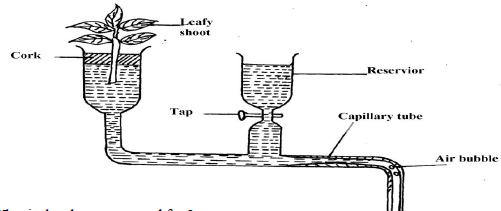
(a) What is the photometer used for ?
(b) State the precautions which should be taken when setting up a photometer
(c) Explain what you will expect if set up was placed under the following environmental conditions;
(i) Dark room
(ii) Leafy shoot enclosed in polythene bag
(iii) In a current of air created by a fan
Date posted:
October 4, 2019
.
Answers (1)
-
The flow chart below shows a blood transfusion pathway.
(Solved)
The flow chart below shows a blood transfusion pathway.

(a) What three conclusions can you draw from the flow chart?
(b) State two precautions that must be observed during blood transfusion
(c) Explain how blood clot is formed once a blood vessels is injured
Date posted:
October 4, 2019
.
Answers (1)
-
Outline the route taken by a molecule of glucose from the ileum up to the kidney.
(Solved)
Outline the route taken by a molecule of glucose from the ileum up to the kidney.
Date posted:
October 4, 2019
.
Answers (1)
-
(a) Why are xylem vessels more efficient in the transport of water than tracheids?
(b) What is the significance of xylem vessels being dead?
(Solved)
(a) Why are xylem vessels more efficient in the transport of water than tracheids?
(b) What is the significance of xylem vessels being dead?
Date posted:
October 4, 2019
.
Answers (1)
-
The diagrams below show stages in the process of feeding shown by amoeba
(Solved)
The diagrams below show stages in the process of feeding shown by amoeba
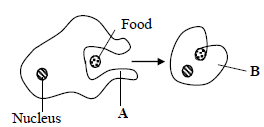
(a) Name the part labeled A.
(b) Name the process illustrated in the diagram above.
(d) Name the type of cell in human beings that exhibit this process
Date posted:
October 4, 2019
.
Answers (1)
-
A transfusion of RH+ blood was given to a patient with Rh- blood. After one week a similar transfusion was given to the same patient....
(Solved)
A transfusion of RH+ blood was given to a patient with Rh- blood. After one week a similar transfusion was given to the same patient. What was likely to be the effect of the second transfusion?
Date posted:
October 4, 2019
.
Answers (1)